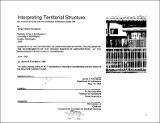Interpreting territorial structure : the machiya of Kyoto and the rowhouses of Boston's South End
Author(s)
Moore, James Robert Finn
DownloadFull printable version (6.956Mb)
Other Contributors
Massachusetts Institute of Technology. Dept. of Architecture.
Advisor
N. John Habraken.
Terms of use
Metadata
Show full item recordAbstract
This thesis focuses on the structure of territory, and how a sense of physical and psychological retreat can be achieved by manipulating territorial principles as one moves through layers of space in an urban context. The machiya or rowhouses of Kyoto are a sophisticated example of a building type which successfully creates a sense of privacy and contemplative retreat within a dense urban context. Through a study of the principles of spatial manipulation and architectural design of the machiya in Japan, some generic techniques are identified which can be applied to other types of rowhouses to add complexity and depth to the experience of space within a confined area. The principles which are gleaned from the Japanese examples are then applied to a local rowhouse type, in the South End in Boston, to explore the implications of increased spatial complexity and layering in the American urban context. The thesis is divided into two parts: first, a discussion of generic issues of territory, and observations of the territorial structure of Kyoto and the South End; then, the development and application of a thematic system for exploring territorial interpretations at the level of the dwelling, cluster of dwellings, and the urban tissue.
Description
Thesis (M. Arch.)--Massachusetts Institute of Technology, Dept. of Architecture, 1988. Bibliography: p. 82-84.
Date issued
1988Department
Massachusetts Institute of Technology. Department of ArchitecturePublisher
Massachusetts Institute of Technology
Keywords
Architecture.